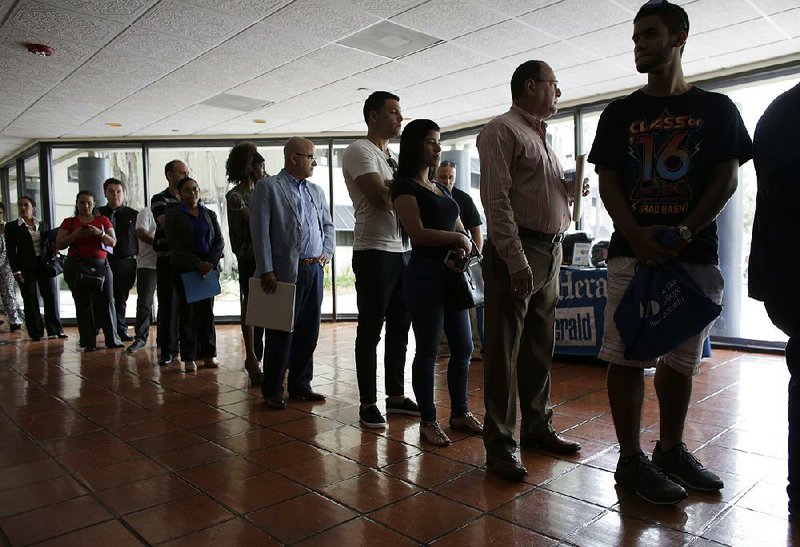WASHINGTON -- U.S. employers added 156,000 jobs in September, and an influx of job seekers lifted the unemployment rate slightly to 5 percent, the Labor Department reported Friday. Analysts said the rise in the number of people seeking work is an encouraging sign that Americans are more optimistic about their prospects.
The job gain last month, though modest, suggested the U.S. economy remains steady if not particularly strong, analysts said. Wages also rose and are now increasing at a healthier pace than they were earlier in the economic recovery -- a trend that may be drawing more people into the job market to look for work.
For much of the recovery, the proportion of Americans who either had a job or were looking for one had been declining as an aging population led to many retirements. Many of the unemployed also grew discouraged about their prospects. Others stayed in school or remained at home caring for relatives.
Yet in the past year, the proportion of adults either working or looking for work has risen from a 40-year low of 62.4 percent to 62.9 percent. That is still far below prerecession levels. But the proportion has increased even while many people in the vast baby boom generation have been retiring.
So far this year, job growth has averaged 178,000 a month, down from last year's pace of 229,000. Still, hiring even at this year's level is enough to lower the unemployment rate over time. And economists have been expecting the pace of job growth to slow as the supply of unemployed workers declines.
"The labor market is getting tighter. That's good news, so we shouldn't expect job growth of 200,000 per month," said Gus Faucher, deputy chief economist at PNC Financial Services Group.
"The slowing in job growth from 2015 is expected," he said. "It's consistent with a labor market that is approaching full employment."
The September hiring figures will probably keep the Federal Reserve on track to raise the short-term interest rate it controls by December, economists said. After seven years of pinning that rate at a record low near zero to try to spur more borrowing and spending, the Fed raised its rate modestly in December. It has not acted since.
"The September payroll report was a decent report that shows moderate job growth continues," Scott Anderson, chief economist at Bank of the West, wrote in a note. "In many ways, it was a 'Goldilocks' number -- not too hot or not too cold -- for the market and the Fed."
A rate increase still isn't a sure thing, as two more employment reports remain this year and the Fed has repeatedly backed away from its previous forecasts for higher rates.
"Come back again next month," said Michael Gapen, New York-based chief U.S. economist for Barclays PLC, who previously worked at the Fed. Friday's report "has something for everybody, and therefore it is unlikely to move the market thinking or Fed thinking about a December rate hike."
Friday's report also comes a month before voters will decide a presidential election in which the two major nominees have sketched out wildly conflicting views of the economy's health and what should be done to stimulate its growth.
Stock investors didn't appear to respond much to the jobs report. The Dow Jones industrial average fell 28 points. Other indexes also fell.
In September, average hourly pay rose 6 cents to $25.79 and is now up 2.6 percent from a year ago. That's better than the gains for most of the seven-year economic recovery, during which pay has increased at a tepid pace of about 2 percent a year. The pay increases, modest as they are, suggest that many employers are being forced to pay more to attract workers.
Yet wage gains are still lagging behind the roughly 3.5 percent pace that has long been consistent with a healthy economy.
Nearly all the net job gains last month occurred in the services industries, including such higher-paying services as management and technical consulting, accounting and computer networking.
Manufacturers shed jobs for a second month in a row, cutting 13,000. Manufacturers have struggled for the past 18 months as businesses have reduced their spending on machinery and other equipment.
Last month, construction added 23,000 positions and retail 22,000. Employers added 15,000 jobs in a category that includes restaurants, hotels and casinos, its slowest gain since May. Hiring also slowed in the education and health sectors.
Recent data suggest that the economy is picking up after a weak start to the year, though growth is unlikely to accelerate much.
Consumer spending was flat in August, the weakest showing in five months. And factories have struggled as businesses have put off investing in new machinery, computers and other equipment.
Still, a recent private survey found that manufacturing expanded in September after shrinking in August. Orders for factory goods jumped, suggesting that output may rise further.
Consumers also appear increasingly confident about the economy, which could stimulate a rebound in spending. Consumer confidence reached a nine-year high last month.
Retailers are expecting robust Christmas spending. The National Retail Federation projects that spending will rise 3.6 percent this year from last year. That's better than last year's gain and slightly above the 3.4 percent average since the recession officially ended in 2009.
Information for this article was contributed by Christopher S. Rugaber of The Associated Press, Shobhana Chandra of Bloomberg News and Jim Puzzahghera of the Los Angeles Times.
Business on 10/08/2016
